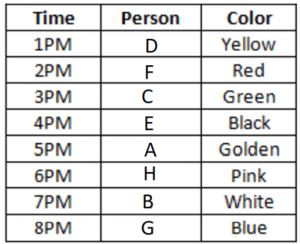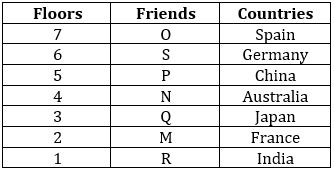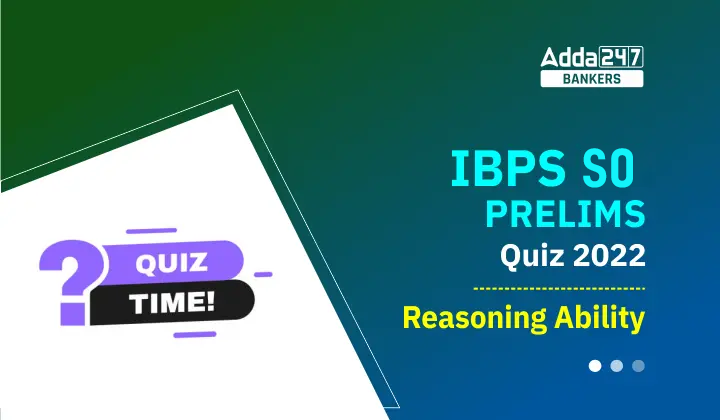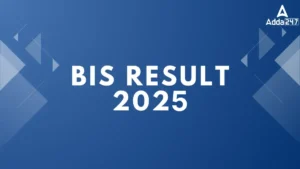Direction (1-5): A number arrangement machine when given an input line of numbers rearranges them following a particular rule in each step. The following is an illustration of input and rearrangement:
Input: 2538 5628 8516 7524 6325 2645
Step I: 2358 2568 1568 2457 2356 2456
Step II: 1568 2356 2358 2456 2457 2568
Step III: 56 35 35 45 45 56
Step IV: 11 8 8 9 9 11
Step V: 121 64 64 81 81 121
Step VI: 2 24 24 8 8 2
Step VI is the last step of the rearrangement. As per the rules followed in the above steps, find out in each of the following questions the appropriate steps for the given input.
Input: 3846 9213 8273 7341 5218 3285 6925 4758
Q1. What will be the addition of the numbers which is second, fourth, sixth and eight from the left end in step IV?
(a) 32
(b) 23
(c) 38
(d) 40
(e) None of these
Q2. Which of the following would be the difference of the numbers which is 2nd from the left end in step I and fourth from the right end in Step II?
(a) 1138
(b) 1287
(c) 1139
(d) 2125
(e) None of these
Q3. Which of the following element will be 3rd to the left of 7th from the left end in step III?
(a) 34
(b) 37
(c) 25
(d) 35
(e) None of these
Q4. Which of the following will be the last step of the given input?
(a) 10 36 36 24 1 2 1 16
(b) 25 49 49 64 100 121 100 144
(c) 10 36 36 24 0 2 0 16
(d) 25 49 49 64 0 121 0 144
(e) None of these
Q5. What is the difference between the number which is second from the right end in step V and the number which is fifth from the left end in step IV?
(a) 93
(b) 90
(c) 114
(d) 54
(e) None of these
Direction (6-10): Read the following information carefully to give the answers to the questions based on it.
Eight persons A, B, C, D, E, F, G, and H came to attend a party but they all reached the venue at different times viz. 1 PM, 2 PM, 3 PM, 4 PM, 5 PM, 6 PM, 7 PM and 8 PM in a single day, but not necessarily in the same order. They all came in different colours of cars – red, yellow, green, white, black, blue, pink, and golden, but not necessarily in the same order.
The one who reached at 4 PM used the black car. A reached at an odd-numbered hour but after 3 PM. The number of persons reached between A and the one who used the blue car is the same as the number of persons reached between A and F. The one who used the yellow car reached first. H reached the venue at an even-numbered hour and used a pink car. There are two persons reached between B and E. F reached before A. F used a red car.B used a white car. G reached just after the one who used the white car. The number of persons reached between the one who used the white car and the one who used the black car is two. D reached before C. The number of persons reached between the one who used the golden car and C is the same as the number of persons reached between C and D.
Q6. How many persons reached the venue between the one who used golden car and the one who used blue car?
(a) Six
(b) One
(c) Four
(d) Two
(e) Three
Q7. Four of the following five are alike in a certain manner and hence form a group. Find the one who does not belong to that group?
(a) G
(b) H
(c) E
(d) F
(e) D
Q8. At what time did H reach the venue?
(a) 6PM
(b) 2PM
(c) 8PM
(d) 4PM
(e) None of these
Q9. B is related to pink in the same way as E is related to green. Then, which of the following is F related to?
(a) White
(b) Yellow
(c) Golden
(d) Pink
(e) None of these
Q10. Which of the following combination is correct?
(a) 4PM – H
(b) D – Golden
(c) 2PM – C
(d) 7PM – B
(e) None is correct
Directions (11-15): Study the following information carefully and answer the question given below-
Seven persons are living on different floors of seven storey building. Ground floor is numbered as 1st and top floor is numbered as 7th floor, also they belong different countries. There are four floors in between S and R who is from India. P lives on an odd numbered floor just above N who doesn’t live on 2nd floor. The one who belongs to Japan and lives just above M. The one, who is from Spain lives on an odd numbered floor. S does not live on ground floor. M does not belong to china. The one who is from China lives on an odd numbered floor just above the one who is from Australia. S is not from Australia and France. O lives one of the floors above Q. Not more than one floor in between the one who belongs to Japan and the one who belongs to China. The one who belongs to Germany lives on an even numbered floor above P. S is not belongs to Japan.
Q11. Who among the following belongs to Germany?
(a) the one who lives on 4th floor
(b) M
(c) P
(d) The one who lives immediate below O
(e)None of these
Q12. How many persons lives in between O and M?
(a) Two
(b) Three
(c) None
(d) One
(e) More than Three
Q13. R lives in which of the following floor?
(a) 4th floor
(b) 1st floor
(c) 3rd floor
(d) 7th floor
(e) 6th floor
Q14. Which of the following statement is true?
(a) N lives on 6th floor
(b) P live immediate above Q
(c) M belongs to France
(d) S lives immediate below the one who belongs to china
(e) None is true
Q15. Who among the following person lives on 3rd floor?
(a) The one who belongs to Japan
(b) R
(c) the one who belongs to Spain
(d) S
(e) None of these
Solutions
Solutions (1-5):
Sol. The logic for the given arrangement will be:
Step I: All the digits of the given numbers are arranged in ascending order within the numbers.
Step II: All the numbers obtained in step I are arranged in ascending order from the left end.
Step III: First and last digits of the numbers are omitted.
Step IV: The digits of the numbers obtained in step III are added.
Step V: Square of each number obtained in step IV.
Step VI: Multiply all digits in each number.
Input: 3846 9213 8273 7341 5218 3285 6925 4758
Step I: 3468 1239 2378 1347 1258 2358 2569 4578
Step II: 1239 1258 1347 2358 2378 2569 3468 4578
Step III: 23 25 34 35 37 56 46 57
Step IV: 5 7 7 8 10 11 10 12
Step V: 25 49 49 64 100 121 100 144
Step VI: 10 36 36 24 0 2 0 16
S1. Ans. (c)
S2. Ans. (c)
S3. Ans. (d)
S4. Ans. (c)
S5. Ans. (b)
Solutions (6-10):
Sol.

S6. Ans. (d)
S7. Ans. (e)
S8. Ans. (a)
S9. Ans. (b)
S10. Ans. (d)
Solution (11-15):
Sol.

S11. Ans. (d)
S12. Ans. (e)
S13. Ans. (b)
S14. Ans. (c)
S15. Ans. (a)





 GA Capsule for SBI Clerk Mains 2025, Dow...
GA Capsule for SBI Clerk Mains 2025, Dow...
 The Hindu Review October 2022: Download ...
The Hindu Review October 2022: Download ...
 BIS Result 2024-25 Out for ASO, JSA and ...
BIS Result 2024-25 Out for ASO, JSA and ...





